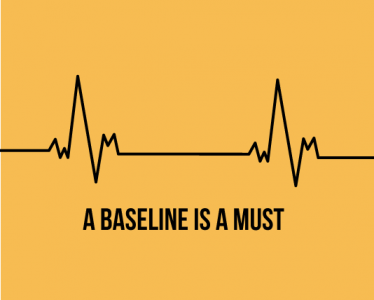uHIT Assessment Baselines
Zone and Pitch Recognition Baselines
General Trends from 1 Year of Assessments
Jun 1, 2023
Youth, High School, College and Pro
What are the baselines for the uHIT Assessment by age / level?
What is the uHIT Custom Assessment?
As we started training hitters of various ages, we realized that youth players don’t need to master MLB-level breaking balls. So it was kind of unfair to give 10-year-old hitters the same assessment we’d give MLB hitters. We needed level-specific baselines for hitters’ vision. So why not match the pitch types and speeds to those most common to youth and high school levels? We could then leave college and pro hitters in a class of their own, right?
And that’s just what we did with the uHIT Custom Assessment (see more here and here). As the start to training, the speeds in your assessment are the basis from which all your training originates. Based on our research, we picked the following pitch speeds and types to make the assessments challenging for each level. If they seem a little lower than speeds at a given level, it is because we want to catch a wide range of possible pitches to evaluate a hitter’s vision performance in uHIT. It’s always better to be a little too easy in an assessment because the training that follows will always make it more hard.
Breaking down the uHIT Custom Assessment by level and sport
With these principles in mind, we chose the following parameters for each level’s Assessment in uHIT Custom:
- Youth (Baseball): Zone Recognition (62-68mph), Pitch Recognition (68mph)
- High School (Baseball): Zone Recognition (76 -83mph), Pitch Recognition (72mph)
- College / Pro (Baseball): Zone Recognition (82 -90mph), Pitch Recognition (78mph)
For softball, we chose parameters to fit those levels’ speeds and pitch types too:
- Youth (Softball): Zone Recognition (44-48mph), Pitch Recognition (46mph)
- High School (Softball): Zone Recognition (50-54mph), Pitch Recognition (52mph)
- College / Pro (Softball): Zone Recognition (56 -60mph), Pitch Recognition (58mph)
We started rolling out these level-specific assessments in Jan/Feb 2022 (see this post for more), completing all levels for all sports in June 2022. Here, we look at some high-level observations after about a year of uHIT Custom Assessments.
Baselines in Pitch Recognition
The journey to provide uHIT Custom Assessment baselines began with Johansen Baseball in Elgin, IL. Ryan Johansen is the founder of this elite baseball training facility and he’s back now from being a hitting tech guy for the Chicago White Sox for several seasons. And he wanted to implement uHIT Custom for vision training (learn more about this training program here) at his facility in a way he never had the flexibility to do at the White Sox. But his first question though was, “How do I tell the players if they’re doing good or bad at these skills?”
The power of baselines
Fortunately for Ryan, we had already collected a year’s worth of data at this point in baseball to tell him where each of his players stacked up. Each Assessment gives you an Accuracy and Reaction Time (or RT) score. Together, these two numbers summarize how well you are doing Pitch (and further below, Zone) Recognition in uHIT. The nominal values we see by level are:
- Pro: Accuracy 66%; RT 0.44sec
- College: Accuracy 60%; RT 0.46sec
- High School: Accuracy 55%; RT 0.48sec
- Youth: Accuracy 52%; RT 0.50sec
The graph below shows this visually:

Moving Baselines Up and In
From the red ovals to the lighter grays, it’s obvious that the pro hitters are both faster and more accurate at recognizing pitch types. So the key for any hitter, regardless of the level he’s training at is to be “up and in” on this graph. “Up” means your Accuracy is high. “In” means your Reaction Time is quick.
Going back to Johansen Baseball, they use this graph when doing a new player’s assessment in the facility. After he finishes, Coach Johansen takes a marker and colors it on the board based on the player’s Accuracy and Reaction Time. “So, that’s the starting point,” he tells them. “And the goal is for you to work the uHIT Custom training to go ‘up and in’ on this graph with every Re-Assessment.
Baselines in Zone Recognition
Completing the picture, we now turn to the zone recognition assessments. These assessments evaluate a player’s ability to predict whether pitches will land in the strike zone, or not. Again, the pitch speeds are driven by level, with Youth seeing the slowest (easiest) pitches and College/Pro seeing the fastest (hardest).
The power of baselines
As before, we summarize the Zone Recognition Assessment with Accuracy and Reaction Time (or RT) scores. Together, these two numbers summarize how well you are doing Zone Recognition in uHIT. And the nominal values we see by level are:
- Pro: Accuracy 72%; RT 0.42sec
- College: Accuracy 66%; RT 0.44sec
- High School: Accuracy 60%; RT 0.47sec
- Youth: Accuracy 57%; RT 0.51sec
The graph below shows this visually:

Moving Baselines Up and In. Again.
Again, going from the red ovals to the lighter grays, it’s obvious that the pro hitters are both faster and more accurate. Now, this trend is for recognizing when a ball is going to be in the zone and accurately predicting that. As above, the key is to be “up and in” on this graph. “Up” means your Accuracy is high. “In” means your Reaction Time is quick.
Johansen Baseball uses this graph too when doing a new player’s assessment in the facility. And this way, a player’s Accuracy and Reaction Time can easily be marked on this graph so he knows where he’s starting his training. From there, the uHIT Custom Training takes him “up and in” on this graph, as he refines his skills in zone recognition.

